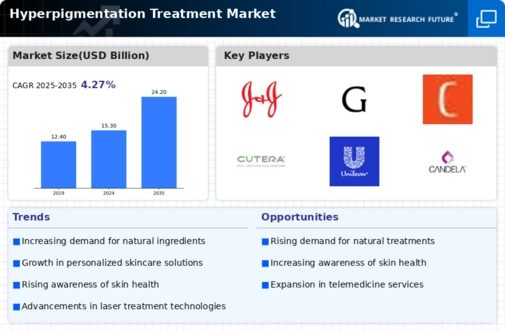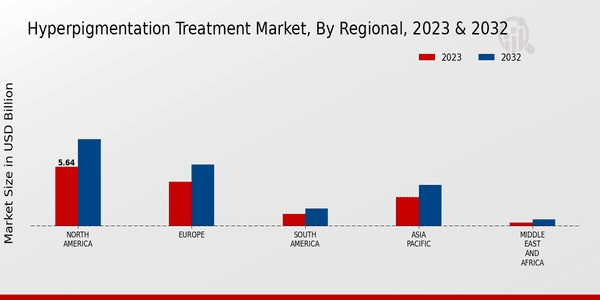Market Growth Projections
The Global Hyperpigmentation Treatment Market Industry is projected to experience substantial growth over the coming years. With a market value of 15.3 USD Billion in 2024, it is expected to expand to 24.2 USD Billion by 2035. This growth trajectory suggests a compound annual growth rate of 4.28% from 2025 to 2035. Such projections indicate a robust demand for hyperpigmentation treatments, driven by various factors including increased awareness, advancements in research, and the rising incidence of skin disorders. The market's evolution reflects a broader trend towards prioritizing skin health and aesthetics in consumer behavior.
Rising Awareness of Skin Health
The increasing awareness regarding skin health and aesthetics among consumers drives the Global Hyperpigmentation Treatment Market Industry. Individuals are becoming more informed about skin conditions, leading to a higher demand for effective treatments. This trend is particularly evident in urban areas where access to information is more prevalent. As a result, the market is projected to reach 15.3 USD Billion in 2024, reflecting a growing consumer base seeking solutions for hyperpigmentation. The emphasis on personal grooming and skincare routines further propels this demand, indicating a shift towards proactive skin health management.
Expansion of E-commerce Platforms
The expansion of e-commerce platforms significantly influences the Global Hyperpigmentation Treatment Market Industry. Online retailing provides consumers with convenient access to a wide range of hyperpigmentation treatments, including both prescription and over-the-counter options. This accessibility is particularly beneficial for individuals in remote areas where traditional retail options may be limited. The growth of e-commerce is expected to facilitate market penetration, allowing brands to reach a broader audience. As a result, the market is poised for substantial growth, with projections indicating a potential market size of 24.2 USD Billion by 2035, driven by the increasing preference for online shopping.
Diverse Treatment Options Available
The availability of diverse treatment options for hyperpigmentation enhances the appeal of the Global Hyperpigmentation Treatment Market Industry. Consumers can choose from a variety of therapies, including topical agents, chemical peels, and laser treatments, catering to different preferences and skin types. This variety not only meets the specific needs of individuals but also encourages experimentation with different modalities. As more options become available, the likelihood of successful treatment increases, fostering consumer confidence. The market's growth is indicative of this trend, with an anticipated increase in value to 15.3 USD Billion by 2024, reflecting the demand for tailored solutions.
Increasing Incidence of Skin Disorders
The rising incidence of skin disorders, including hyperpigmentation, serves as a crucial driver for the Global Hyperpigmentation Treatment Market Industry. Factors such as environmental pollution, excessive sun exposure, and lifestyle changes contribute to the prevalence of these conditions. This trend is particularly pronounced in regions with high UV exposure, where individuals are more susceptible to skin damage. As awareness of these issues grows, the demand for effective treatment options is likely to increase. The market's growth trajectory suggests a compound annual growth rate of 4.28% from 2025 to 2035, reflecting the urgent need for solutions to address skin health concerns.
Advancements in Dermatological Research
Innovations in dermatological research contribute significantly to the Global Hyperpigmentation Treatment Market Industry. New formulations and technologies are emerging, offering more effective and safer treatment options for hyperpigmentation. For instance, the development of novel topical agents and laser therapies has enhanced treatment efficacy, appealing to a broader demographic. As research continues to evolve, it is anticipated that the market will expand, potentially reaching 24.2 USD Billion by 2035. These advancements not only improve patient outcomes but also foster greater trust in dermatological treatments, thereby encouraging more individuals to seek help for their skin concerns.








